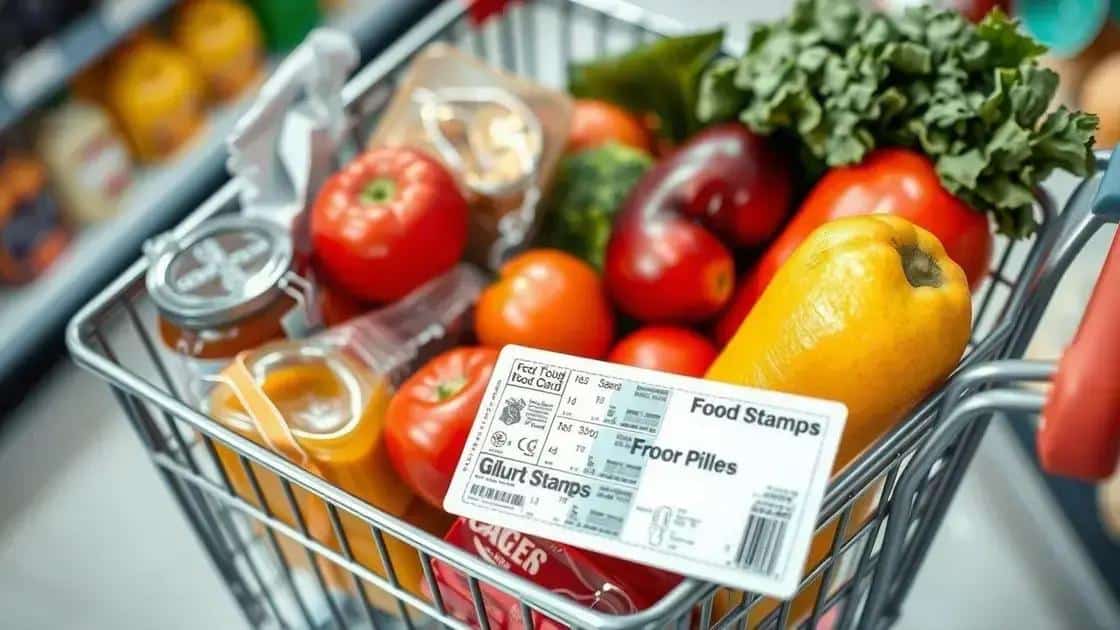Food stamps: a lifeline for those in need

Anúncios
Food stamps provide crucial assistance to low-income families, enabling them to purchase nutritious food, thereby improving their overall health and well-being.
Food stamps have long been a crucial support system for individuals and families facing financial hardships. But how do these programs work in practice? Let’s explore the nuances and benefits of food stamps that might surprise you.
Understanding food stamps and their purpose
Understanding food stamps is crucial in knowing how they help low-income families. These programs are designed to assist those in need by providing necessary resources to purchase food, ensuring that no one goes hungry. Food stamps, now often referred to as the Supplemental Nutrition Assistance Program (SNAP), play a vital role in supporting our communities.
The Purpose of Food Stamps
The main purpose of food stamps is to alleviate hunger and provide nutritional support. They empower families to make healthier food choices, thus contributing to their overall well-being. When families receive food stamps, they can buy groceries that meet their dietary needs.
Key Benefits of Food Stamps
- Access to healthier food options.
- Reduction in food insecurity.
- Support for local economies through increased grocery spending.
- Encouragement of better nutrition and healthier eating habits.
Moreover, food stamps help nurture children by ensuring they receive the nutrients necessary for growth and development. By creating access to affordable food, families can focus on other essential expenses such as housing and healthcare, providing relief during tough economic times.
Additional Insights
Eligibility for food stamps often depends on income level and family size. It’s important for families to understand the qualifications to benefit from these programs. Food stamps can also have long-term effects on improving family health and stability, making them a key tool for societal change.
In summary, understanding food stamps allows us to appreciate their role in combating hunger. The support they provide is invaluable, not just for the individuals who use them but also for the overall health of the community.
How food stamps benefit families in need

Food stamps are designed to support families in need by providing them the resources to purchase nutritious food. This assistance can greatly improve the quality of life for many households facing financial strain.
Direct Benefits of Food Stamps
The most obvious benefit of food stamps is access to food. They allow families to buy essential groceries, which can reduce stress about daily meals. When families have enough to eat, they tend to be healthier and happier. Studies show that food security is linked to better physical and mental health outcomes.
Economic Impact
- Increased purchasing power for low-income families.
- Support for local grocery stores and markets.
- Stimulating local economies through food-related spending.
- Reduction in poverty levels in the community.
Using food stamps can free up family budgets. With less spent on food, families can allocate funds toward other necessities, such as transportation or childcare. This flexibility can lead to improved overall family stability.
Quality of Life Improvements
Accessing food stamps not only alleviates hunger but also fosters a sense of dignity and empowerment. Families can choose healthier food options, which is especially important for children’s growth and development. Stronger family bonds may form as members gather around meals that they can now afford to share.
For many, food stamps serve as a stepping stone towards financial independence. When families feel secure about their food situation, they can focus on education and employment opportunities, leading to a brighter future.
Eligibility requirements for food stamp programs
The eligibility requirements for food stamp programs are essential to understand for those seeking assistance. These requirements help ensure that those who truly need support can access it. Generally, eligibility is based on a few key factors, primarily income, household size, and resources.
Income Guidelines
To qualify for food stamps, a family’s income must fall below a certain threshold. This threshold varies based on household size. The government regularly updates these limits, so it’s important to check the current figures.
Household Size
- The number of individuals living in a household is crucial.
- More people in the household typically mean a higher income limit.
- Children and elderly members are often considered differently in calculations.
Additionally, resources such as bank accounts and vehicles can influence eligibility. Families with higher savings may not qualify. Therefore, it’s crucial to know what counts as a resource. Eligible resources are usually limited to a certain amount, and this can include cash or investments.
Special Considerations
Some groups may have different rules. For example, elderly or disabled individuals might have more lenient criteria. Moreover, families experiencing temporary hardships, such as job loss, may be eligible even if they normally wouldn’t qualify.
Gathering the necessary documentation is an important step in the application process. Applicants should prepare to provide proof of income, identification, and residency. This information will help speed up the approval process. Understanding these eligibility requirements can make the journey toward receiving assistance clearer and more manageable.
Tips for maximizing food stamp benefits

Maximizing food stamp benefits can greatly enhance the nutritional quality of meals for families. Understanding how to make the most of these benefits is essential. By planning meals wisely and using resources effectively, families can stretch their food budgets further.
Meal Planning
One of the best strategies is to create a meal plan for the week. This helps in making smart decisions about what to buy and avoids unnecessary purchases at the store. When families know what they will eat, they can stick to their grocery lists. Planning also allows for bulk buying of staple items.
Using Coupons and Promotions
- Look for store promotions that can help save more money.
- Use coupons whenever possible to reduce total grocery costs.
- Take advantage of loyalty programs offered by grocery stores.
Additionally, many stores have specific days where discounts are available, especially for certain food items nearing expiration. Shopping on these days can help families get more for their benefits.
Choosing Healthy Options
Maximizing benefits isn’t just about quantity; it’s also about quality. Select healthier options like fresh fruits and vegetables, whole grains, and lean proteins. These foods are vital for maintaining a balanced diet. By prioritizing nutritious choices, families can improve their overall health.
Searching for local food banks and food distribution centers can supplement food stamp benefits as well. Many communities offer assistance programs that provide additional support, which can be a game-changer for struggling families.
Finally, participating in cooking classes can enhance skills in preparing meals that are both cost-effective and nutritious. This knowledge can lead to better food choices and healthier lifestyles.
In conclusion, understanding food stamps and how to maximize their benefits can significantly improve the lives of families in need. By using strategies like meal planning, taking advantage of promotions, and focusing on healthy food choices, families can not only stretch their budgets but also enhance their overall well-being. Food stamps serve as a vital resource, allowing families to prioritize nutrition and make informed dietary choices. With the right knowledge and preparation, families can make the most of these essential benefits and create a brighter, healthier future.
FAQ – Common Questions About Food Stamps
Who is eligible for food stamp programs?
Eligibility generally depends on income level, household size, and resources. Low-income families may qualify for assistance.
How can families maximize their food stamp benefits?
Families can maximize benefits by meal planning, using coupons, choosing healthy foods, and exploring local resources.
What types of food can be purchased with food stamps?
Food stamps can be used to buy groceries like fruits, vegetables, meat, dairy, bread, and other staple foods, but not hot prepared meals.
How do I apply for food stamps?
Applications for food stamps can be submitted online or at local assistance offices. Required documents include proof of income and residency.






